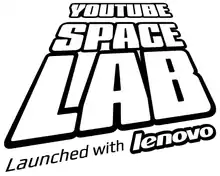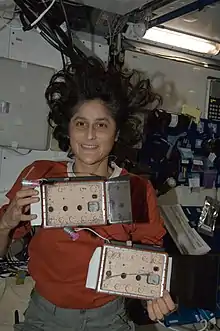YouTube Space Lab
YouTube Space Lab was a 2011–2012 international science competition launched by YouTube and Lenovo, in cooperation with NASA, European Space Agency (ESA), and the Japan Aerospace Exploration Agency (JAXA). Founded by Zahaan Bharmal of Google, the competition challenged teenagers from ages 14–18 to design an experiment to be performed on the International Space Station. The global winners were Amr Mohamed from Alexandria, Egypt, and Dorothy Chen and Sara Ma from Troy, Michigan.

Announcement and finalists
YouTube and Lenovo announced the YouTube Space Lab competition on 10 October 2011. Applicants were challenged to design a microgravity experiment, and submissions closed in early December.[1] On 17 January 2012, YouTube Space Lab announced sixty finalists and started the voting process for the regional winners where over 150,000 YouTube users voted for their favorite experiments. These results were factored alongside YouTube Space Lab's panel of judges, including Stephen Hawking, William Gerstenmaier, Leland Melvin, Akihiko Hoshide, Guy Laliberté,[1][2] and Tshilidzi Marwala.[3] Stephen Hawking, however, was unable to fully participate as a judge at this stage because of health problems, and his position was filled by colleague Paul Shellard.[4]
| Regions | 14- to 16-year-old finalists[2] | 17- to 18-year-old finalists[2] | |
|---|---|---|---|
| Asia Pacific |
|
| |
| Europe, Middle East, and Africa |
|
| |
| The Americas |
|
| |
Regional and global winners
Regional winners were determined by votes cast by the YouTube community factored alongside the votes cast by the competition's panel of judges. On 22 February 2012, YouTube Space Lab announced the following six regional winning teams, two from each international region:[5]
| Regions | 14- to 16-year-old age group | 17- to 18-year-old age group | |||
|---|---|---|---|---|---|
| Group | Experiment | Group | Experiment | ||
| Asia Pacific | Patrick Zeng & Derek Chan (New Zealand) | "Is space too cold for life to exist?" | Sachin S. Kukke (Bangalore, India) | "Could liquid magnets take us deeper into space?" | |
| Europe, Middle East, and Africa | Laura Calvo & María Vilas (Spain) | "Could weightless liquids be the key to better gadgets?" | Amr Mohamed (Alexandria, Egypt) | "Can you teach an old spider new tricks?" | |
| The Americas | Dorothy Chen & Sara Ma (Troy, Michigan, U.S.A.) | "Could alien superbugs cure disease on Earth?" | Emerald Bresnahan (Plainville, Massachusetts, U.S.A.) | "Could a snowflake unlock the mysteries of the universe?" | |
The nine contestants gathered on March in Washington, D.C., to experience a zero-gravity flight on the "Vomit Comet" and to tour the Steven F. Udvar-Hazy Center. They attended the competition award ceremony on 22 March at the Newseum, where Zahaan Bharmal announced the two winning experiments: Dorothy Chen and Sara Ma's bacteria experiment, and Amr Mohamed's jumping spider experiment.[6]
BioServe Space Technologies, from the University of Colorado at Boulder, designed the two experiments using global winners' ideas.[7] Dorothy and Sara went to the Tanegashima Space Center in Japan in late July to watch the Kounotori 3 launch the winning experiments into space. Instead of attending the launch, Amr chose to later go through cosmonaut training at the Yuri Gagarin Cosmonaut Training Center in Star City, Russia.[8][9]
Livestream and results

On 13 September 2012, Bill Nye hosted a live-stream interview connecting the three global winners with astronaut Sunita Williams. Sunita, who had performed the experiments on the ISS, gave the preliminary results for these experiments. Dorothy and Sara had hypothesized that the Bacillus subtilis would become more efficient germ-fighters in microgravity, and the initial results showed signs of growth. However, the specimens would have to be taken back to Earth for further testing. Amr's experiment examined the predatory behavior of the jumping spider, and the ISS reported that Amr's spider, named Nefertiti and nicknamed Neffi, had successfully adapted to catch its prey in microgravity.[10]
Nefertiti returned to Earth on 30 November 2012 and lived at the O. Orkin Insect Zoo in Washington, D.C., until she died four days later.[11] Nefertiti's traveling companion, a zebra spider named Cleopatra, died soon after touchdown.[12]
References
- "YOUTUBE SPACE LAB LIFTS OFF WITH LENOVO ABOARD" (PDF). YouTube Space Lab Resources (Press release). Google Sites. 10 October 2012. Retrieved 2013-01-12.
- "YouTube Space Lab Announces 60 Finalists in Competition to Send Students' Experiments into Space" (PDF). YouTube Space Lab Resources (Press release). Google Sites. 17 January 2012. Retrieved 2013-01-12.
- "Marwala to work with Stephen Hawkins". The Star (South Africa). 29 September 2011. Archived from the original on 18 November 2018. Retrieved 28 November 2016.
- "Judges". YouTube Space Lab Resources. Google Sites. Retrieved 2013-01-02.
- "YouTube Space Lab and Lenovo Announce Six Regional Winners in Science Competition: Two Global Winners' Experiments To Be Conducted in Space". YouTube Space Lab (Press release). Google Sites. 22 February 2012. Retrieved 10 January 2013.
- "YouTube Space Lab and Lenovo Announce Two Global Winners in Science Competition". YouTube Space Lab (Press release). Google Sites. 22 March 2012. Retrieved 12 January 2013.
- "CU-Boulder plays key role in global student space experiment competition". University of Colorado Boulder. 10 September 2012. Retrieved 12 January 2013.
- Moscowitz, Clara (20 July 2012). "Student Science Experiments Riding Japanese Rocket to Space Station". Space.com. TechMediaNetwork. Retrieved 12 January 2013.
- O'Hara, Gavin (24 July 2012). "Star City Dreaming With Amr from Space Lab". Lenovo Blogs. Lenovo Social Media. Retrieved 24 January 2013.
- "Results of Winning Experiments Revealed Live from Space Live event on YouTube hosted by Bill Nye 'The Science Guy'". YouTube Space Lab (Press release). Google Sites. 13 September 2012. Retrieved 12 January 2013.
- Brennan, Charlie (3 December 2012). "'Spidernaut' survives CU-Boulder mission to space, but not the Smithsonian". Daily Camera. Retrieved 7 December 2012.
- Urquart, Conal (2012-12-05). "Jumping spider that pioneered space travel dies in museum". The Guardian. Retrieved 2021-04-28.
External links
- Official YouTube channel
- Resources site
- YouTube Space Lab at NASA.gov
- Nefertiti, the Spidernaut, children's picture book by Darcy Pattison